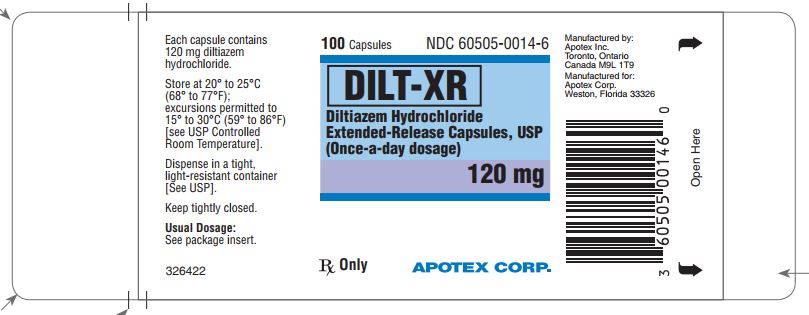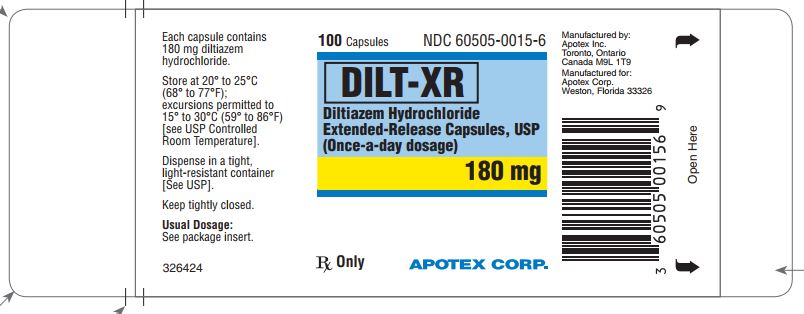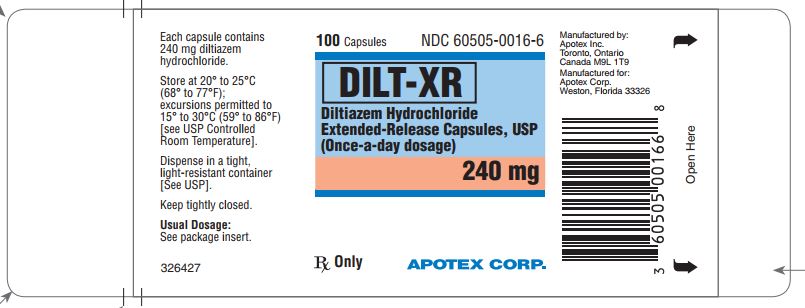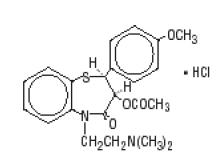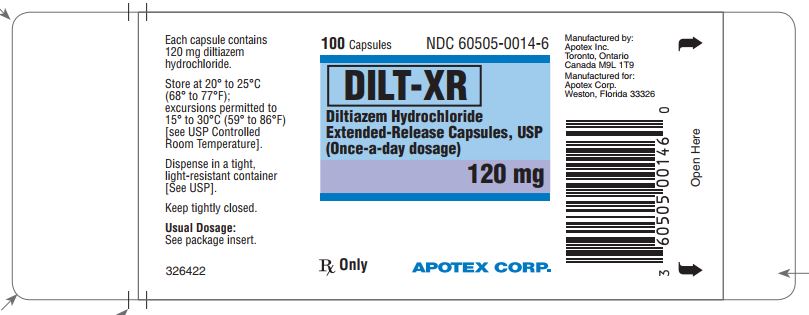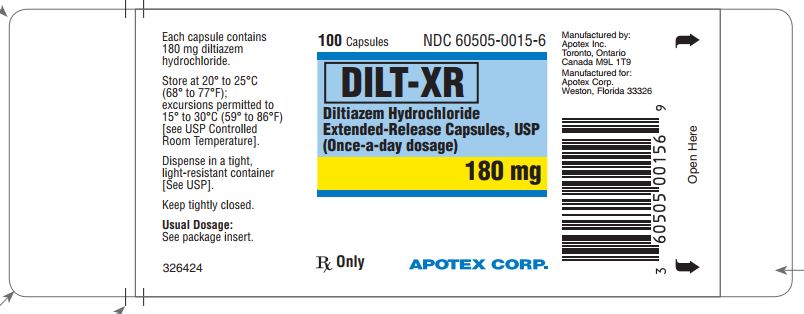The therapeutic benefits of diltiazem hydrochloride are believed to be related to its ability to inhibit the influx of calcium ions during membrane depolarization of cardiac and vascular smooth muscles.
Hemodynamic and Electrophysiologic Effects
Like other calcium antagonists, diltiazem decreases sinoatrial and atrioventricular conduction in isolated tissues and has a negative inotropic effect in isolated preparations. In the intact animal, prolongation of the AH interval can be seen at higher doses.
In man, diltiazem prevents spontaneous and ergonovine-provoked coronary artery spasm. It causes a decrease in peripheral vascular resistance and a modest fall in blood pressure in normotensive individuals. In exercise tolerance studies in patients with ischemic heart disease, diltiazem reduces the double product (HR x SBP) for any given work load. Studies to date, primarily in patients with good ventricular function, have not revealed evidence of a negative inotropic effect. Cardiac output, ejection fraction and left ventricular end diastolic pressure have not been affected. Such data have no predictive value with respect to effects in patients with poor ventricular function. Increased heart failure has, however, been reported in occasional patients with pre-existing impairment of ventricular function. There are as yet few data on the interaction of diltiazem and beta-blockers in patients with poor ventricular function. Resting heart rate is usually slightly reduced by diltiazem.
Diltiazem Hydrochloride Extended-Release Capsules, USP (Once-a-day dosage) produce antihypertensive effects both in the supine and standing positions. Postural hypotension is infrequently noted upon suddenly assuming an upright position. Diltiazem decreases vascular resistance, increases cardiac output (by increasing stroke volume), and produces a slight decrease or no change in heart rate. No reflex tachycardia is associated with the chronic antihypertensive effects.
During dynamic exercise, increases in diastolic pressure are inhibited while maximum achievable systolic pressure is usually reduced. Heart rate at maximum exercise does not change or is slightly reduced.
Diltiazem antagonizes the renal and peripheral effects of angiotensin II. No increased activity of the renin-angiotensin-aldosterone axis has been observed. Chronic therapy with diltiazem produces no change or an increase in plasma catecholamines. Hypertensive animal models respond to diltiazem with reductions in blood pressure and increased urinary output and natriuresis without a change in the urinary sodium/potassium ratio. In man, transient natriuresis and kaliuresis have been reported, but only in high intravenous doses of 0.5 mg/kg of body weight.
Diltiazem-associated prolongation of the AH interval is not more pronounced in patients with first-degree heart block. In patients with sick sinus syndrome, diltiazem significantly prolongs sinus cycle length (up to 50% in some cases). Intravenous diltiazem in doses of 20 mg prolongs AH conduction time and AV node functional and effective refractory periods approximately 20%.
In two short-term, double-blind, placebo-controlled studies, 303 hypertensive patients were treated with once-daily Diltiazem Hydrochloride Extended-Release Capsules, USP (Once-a-day dosage) in doses of up to 540 mg. There were no instances of greater than first-degree atrioventricular block, and the maximum increase in the PR interval was 0.08 seconds. No patients were prematurely discontinued from the medication due to symptoms related to prolongation of the PR interval.
Pharmacodynamics
In one short-term, double-blind, placebo-controlled study, Diltiazem Hydrochloride Extended-Release Capsules, USP (Once-a-day dosage) 120, 240, 360, and 480 mg/day demonstrated a dose-related antihypertensive response among patients with mild to moderate hypertension. Statistically significant decreases in trough mean supine diastolic blood pressure were seen through 4 weeks of treatment: 120 mg/day (-5.1 mmHg); 240 mg/day (-6.9 mmHg); 360 mg/day (-6.9 mmHg); and, 480 mg/day (-10.6 mmHg). Statistically significant decreases in trough mean supine systolic blood pressure were also seen through 4 weeks of treatment: 120 mg/day (-2.6 mmHg); 240 mg/day (-6.5 mmHg); 360 mg/day (-4.8 mmHg); and 480 mg/day (-10.6 mmHg).
The proportion of evaluable patients exhibiting a therapeutic response (supine diastolic blood pressure <90 mmHg or decrease >10 mmHg) was greater as the dose increased: 31%, 42%, 48%, and 69% with the 120, 240, 360, and 480 mg/day diltiazem groups, respectively. Similar findings were observed for standing systolic and diastolic blood pressures. The trough (24 hours after a dose) antihypertensive effect of Diltiazem Hydrochloride Extended-Release Capsules, USP (Once-a-day dosage) retained more than one-half of the response seen at peak (3 to 6 hours after administration).
Significant reductions of mean supine blood pressure (at trough) in patients with mild to moderate hypertension were also seen in a short-term, double-blind, dose-escalation, placebo-controlled study after 2 weeks of once daily Diltiazem Hydrochloride Extended-Release Capsules, USP (Once-a-day dosage) 180 mg/day (diastolic: -6.1 mmHg; systolic: -4.7 mmHg) and again, 2 weeks after escalation to 360 mg/day (diastolic: -9.3 mmHg; systolic: -7.2 mmHg). However, a further increase in dose to 540 mg/day for 2 weeks provided only a minimal further increase in the antihypertensive effect (diastolic: -10.2 mmHg; systolic: -6.7 mmHg).
Diltiazem Hydrochloride Extended-Release Capsules, USP (Once-a-day dosage), given at 120 mg, 240 mg, and 480 mg/day, in a randomized, multicenter, double-blind, placebo-controlled, parallel group, dose-ranging study, in 189 patients with chronic angina, demonstrated a dose-related increase in exercise time by Exercise Tolerance Test (ETT) and a reduction in rates of anginal attacks (based on individual patient diaries). The improvement in total exercise time (using the Bruce protocol), measured at trough exercise periods, for placebo, 120 mg, 240 mg, and 480 mg, was 20, 37, 49, and 56 seconds, respectively.
Pharmacokinetics and Metabolism
Diltiazem is well absorbed from the gastrointestinal tract, and is subject to an extensive first-pass effect. When given as an immediate release oral formulation, the absolute bioavailability (compared to intravenous administration) of diltiazem is approximately 40%. Diltiazem undergoes extensive hepatic metabolism in which 2% to 4% of the unchanged drug appears in the urine. Total radioactivity measurement following short IV administration in healthy volunteers suggests the presence of other unidentified metabolites which attain higher concentrations than those of diltiazem and are more slowly eliminated; half-life of total radioactivity is about 20 hours compared to 2 to 5 hours for diltiazem. In vitro binding studies show diltiazem HCl is 70% to 80% bound to plasma proteins. Competitive in vitro ligand binding studies have also shown diltiazem HCl binding is not altered by therapeutic concentrations of digoxin, HCTZ, phenylbutazone, propranolol, salicylic acid, or warfarin. The plasma elimination half-life of diltiazem is approximately 3.0 to 4.5 hours. Desacetyldiltiazem, the major metabolite of diltiazem, which is also present in the plasma at concentrations of 10% to 20% of the parent drug, is approximately 25% to 50% as potent a coronary vasodilator as diltiazem. Therapeutic blood levels of diltiazem hydrochloride appear to be in the range of 40 to 200 ng/mL. There is a departure from linearity when dose strengths are increased; the half-life is slightly increased with dose.
A study that compared patients with normal hepatic function to patients with cirrhosis found an increase in half-life and a 69% increase in bioavailability in the hepatically impaired patients. Patients with severely impaired renal function showed no difference in the pharmacokinetic profile of diltiazem compared to patients with normal renal function.
Diltiazem Hydrochloride Extended-Release Capsules, USP (Once-a-day dosage) contain a degradable controlled-release tablet formulation designed to release diltiazem over a 24-hour period. Controlled absorption of diltiazem begins within 1 hour, with maximum plasma concentrations being achieved 4 to 6 hours after administration. The apparent steady-state half-life of diltiazem following once daily administration of Diltiazem HCl Extended-Release Capsules ranges from 5 to 10 hours. This prolongation of half-life is attributed to continued absorption of diltiazem rather than to alterations in its elimination.
The absolute bioavailability of diltiazem from a single dose of Diltiazem Hydrochloride Extended-Release Capsules, USP (Once-a-day dosage) (compared to intravenous administration) is 41% (± 14). The value was shown to be similar to the 40% systemic availability reported following administration of an immediate release diltiazem HCl formulation.
As the dose of Diltiazem Hydrochloride Extended-Release Capsules, USP (Once-a-day dosage) is increased from a daily dose of 120 mg to 240 mg, there is an increase in the AUC of 2.3-fold. When the dose is increased from 240 mg to 360 mg, AUC increases 1.6-fold and when increased from 240 mg to 480 mg, AUC increases 2.4-fold.
In vivo release of diltiazem occurs throughout the gastrointestinal tract, with controlled release still occurring for up to 24 hours after administration, as determined by radio-labeled methods. As the once daily dose of Diltiazem Hydrochloride Extended-Release Capsules, USP (Once-a-day dosage) was increased, departures from linearity were noted. There were disproportionate increases in area under the curve for doses from 120 mg to 480 mg.
The presence of food did not affect the ability of Diltiazem Hydrochloride Extended-Release Capsules, USP (Once-a-day dosage) to maintain a controlled release of the drug and did not impact its sustained release properties over 24-hours after administration. However, simultaneous administration of Diltiazem Hydrochloride Extended-Release Capsules, USP (Once-a-day dosage) with a high-fat breakfast resulted in increases in AUC of 13% and 19%, and in Cmax by 37% and 51%, respectively.

